Member Blog: Mutualistic Relationships in Cannabis – The Benefits of Coexistence
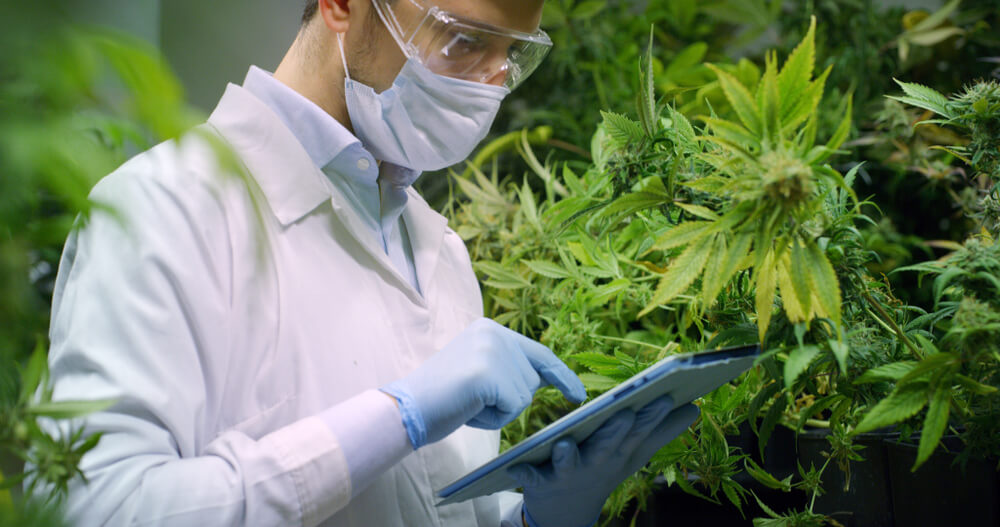
by Angel Fernandez, MyFloraDNA
When it comes to growing healthy plants, it’s easy to focus on avoiding pests, diseases, and other harmful intruders that can wreak havoc on our crops. However, not all microorganisms are bad for our cultures. In fact, some microorganisms can actually benefit our plants in a big way, providing protection, enhancing nutrient uptake, and even increasing resistance to stress and adverse conditions. These microorganisms are called biostimulants, and the relationships they form with plants are known as mutualism.
But, what is mutualism?
All plants host communities of microorganisms that cause no harm to them, in fact, they benefit them. This relationship between one organism and another, where both seem to benefit from their coexistence, is called mutualism. Cannabis plants are no exception; they also create mutualistic relationships with other organisms. In this case, mutualism occurs between microorganisms like bacteria or fungi (or both) and cannabis plants, who lend their tissues to these organisms to inhabit and receive food. In return, microorganisms provide the plant with different benefits like phytohormone supplies, secondary metabolites, and enzyme production stimulation. They also help in the solubilization of minerals and the absorption of nutrients.
One of the most interesting things about mutualistic relationships in cannabis is that they occur all over the plant, but different microorganisms tend to prefer different parts of the plant. Endophyte organisms that live inside the plant can be found in the roots, stems, petioles, seeds, and buds of cannabis plants. Most plants host both bacteria and fungi, but studies show that stems host fungi exclusively. The bacteria and fungi that inhabit the roots are the most popular and are known as mycorrhizas and rhizobacteria. These are organic compounds that promote growth in plants and are mostly used as biostimulants in many cultures.
One of the most significant benefits of mutualism between microorganisms and cannabis is the production of secondary metabolites like CBD and THC. Four specific bacteria taxa, including Comamonas testosteroni, Citrobacter freundii, Enterobacter cloacae, and Pseudomonas putida, have been shown to enhance cannabis plant growth and secondary metabolite production. Evidence suggests that a combination of these four species of bacteria acts as a biostimulant.
Pseudomonas bacterial strains, in particular, benefit cannabis plants by producing diffusible antibiotics that act as pathogen biocontrollers. Bacillus strains also act as a defense barrier against pathogens by preventing them from generating resistance to secondary compounds that plants produce to eliminate them
In addition to bacteria, fungi that live in the roots, called mycorrhizae, help improve water and nutrient absorption in plants and stimulate crop growth by providing bioactive substances. Endophytic cannabis fungi of the genera Paecilomyces, Penicillium, Pantoea, and Trichothecium produce bioactive substances that act as fungicides, especially against the fungus Fusarium oxysporum. These substances not only promise to be a solution to serious problems in cannabis plants as biological control agents against aggressive pathogens but also a sustainable resource and a substitute for chemopesticides on the market. Using them reduces traces of pesticides in cannabis flowers and allows growers to adapt to government regulatory policies that have zero tolerance against pesticides.
So how can we encourage these mutualistic relationships to occur in our plants?
The mutualistic relationships between microorganisms and plants occur naturally without any type of artificial additive, depending on the environmental conditions, the cultivation area, the pH and salinity of the soil, and other characteristics. Some may exist naturally in the substrate or be accidentally transmitted in many ways.
However, cannabis growers can use various methods to introduce these microorganisms into their crops, either on the substrate or directly on the plant. Commercially, some companies sell products with inoculums that contain some strains of fungi and bacteria that encourage plant growth and help protect them from pathogens.
Other ways to acquire these strains are through organic matter such as compost, which is rich in sugars bacteria. Also, older compost that has grown moldy over time can contain beneficial fungal strains for cannabis plants.
In conclusion, mutualism is a beneficial relationship between microorganisms and cannabis plants that can improve crop growth, protect plants from pathogens, and reduce the need for pesticides. By understanding these relationships and encouraging them, growers can promote healthier cannabis plants and contribute to a more sustainable and eco-friendly cultivation process.
 About MyFloraDNA: We are a genomic laboratory based in Woodland California, delivering modern genomics for the Cannabis Industry. \
About MyFloraDNA: We are a genomic laboratory based in Woodland California, delivering modern genomics for the Cannabis Industry. \
Our services include Trait detection (cannabinoid profile and sex/gender ID), Pathogen Detection, and Genetic Validation Services. We offer breakthrough solutions using the inner power of your plants.
Angel Fernandez, author. CEO & Co-Founder at MyFloraDNA. Member of the NCIA’s Scientific Advisory Committee. “It is time to fill in the gap between DNA Sciences and Agriculture. MyFloraDNA is willing to show the huge opportunities that exist for modern genetics in agriculture. Now, it is time for another agricultural revolution”.
Joselyn Guadamuz, co-author. Scientific Researcher and Content Writer at MyFloraDNA.
Maria de Catarina, editor. Public Relations Specialist at MyFloraDNA.
Member Blog: The Importance of Genetic Studies for Identifying Plant Mutations

by Angel Fernandez, Joselyn Guadamuz, and Maria de Catarina of MyFloraDNA
The cannabis industry has experienced significant growth in recent years, highlighting the importance of quality control measures. One of them is the utilization of laboratory partners to ensure the genetic integrity of the products. However, the connection between cannabis and genetic studies is often underappreciated.
A genetic study or test is a type of analysis that is carried out on a tissue or cell to search for essential traits in the genetic material of the plant. The results obtained from these analyses can provide a lot of information that helps confirm or refute many theories.
In recent years, genetic studies of cannabis have played a crucial role in the industry by providing growers with more advanced tools and techniques. These studies have enabled growers to improve crop yields by identifying key traits and characteristics for reproduction. Furthermore, genetic testing has been instrumental in quickly and effectively detecting diseases that affect crops and identifying the gender of the plant well in advance of flowering, thus saving growers time and resources.
Even more, genetic testing also allows cannabis workers to detect changes or damages in the genetic material of their plants.
Plants, like all living organisms, have a complex genetic makeup that plays a crucial role in their growth and development. However, the genetic material of plants can be susceptible to mutations, which are changes in the DNA sequence that can occur naturally or be caused by external factors. These mutations can have varying effects on the plant, from having no impact to causing serious detrimental effects on its growth and development.
One of the main factors that can cause mutations in the genetic material of plants is found in controlled environments such as in vitro culture laboratories. In these environments, plants are exposed to chemicals and UV radiation that can cause mutations in their DNA. However, not all mutations are harmful to plants. For decades, scientists have been making changes to the genetic material of plants with the goal of improving crop quality and characteristics.
While controlled environments can cause mutations in the genetic material of plants, it’s also important to consider the impact of environmental factors in uncontrolled environments, such as outdoor crop plantations. Factors like air (oxygen) and sunlight (UV rays) are two of the main factors influencing mutations in the genetic material of plants. Because these two factors are part of the normal conditions in which a crop lives on a plantation, mutations can be expected to occur at some point in the growth process of plants.
The damage caused by these factors can not only generate simple changes in the genetic material of the plants but can also have serious detrimental effects on the plant, such as growth inhibition. Even subsequent cumulative damage to genetic material can not only prevent plant cells from dividing and growing but can seriously damage tissue and ultimately kill the plant.
Although some of these mutations can be subtle and go undetected, the composition of the plant could have changed at a molecular level, which may mean that, for example, in the case of cannabis, a mutation causes the cannabinoid content to be of poor quality or even non-existent, but to the naked eye the plant looks normal. This is why genetic and molecular studies have played a key role in this industry.
Additionally, if a grower obtains a particularly outstanding trait in their plant, the only way to obtain information on that trait and validate its function is through genetic studies, allowing them to obtain a genetic profile of the plant as proof that it is unique. These studies also work to detect unique, outstanding traits, such as high THC or CBD production in cannabis, which would not be possible without laboratory analysis, as these traits cannot be measured visually.
It is crucial for growers to have a good understanding of the genetic material of their crops in order to ensure that they are of good quality and to detect any mutations that may have a negative impact on the plant. Genetic and molecular studies play a vital role in this industry by providing growers with the necessary information to make informed decisions about their crops, and to ensure that the plants they grow are of the highest quality and free of mutations that could have a negative impact on the final product.
About MyFloraDNA: We are a genomic laboratory based in Woodland California, delivering modern genomics for the cannabis industry.
Our services include Trait detection (cannabinoid profile and sex/gender ID), Pathogen Detection, and Genetic Validation Services. We offer breakthrough solutions using the inner power of your plants.
Angel Fernandez, author. CEO & Co-Founder at MyFloraDNA. Member of the NCIA’s Scientific Advisory Committee. “It is time to fill in the gap between DNA Sciences and Agriculture. MyFloraDNA is willing to show the huge opportunities that exist for modern genetics in agriculture. Now, it is time for another agricultural revolution”.
Joselyn Guadamuz, co-author. Scientific Researcher and Content Writer at MyFloraDNA.
Maria de Catarina, editor. Public Relations Specialist at MyFloraDNA.
Member Blog: What’s in Your Garden? Identifying, Preventing, and Exterminating Pests
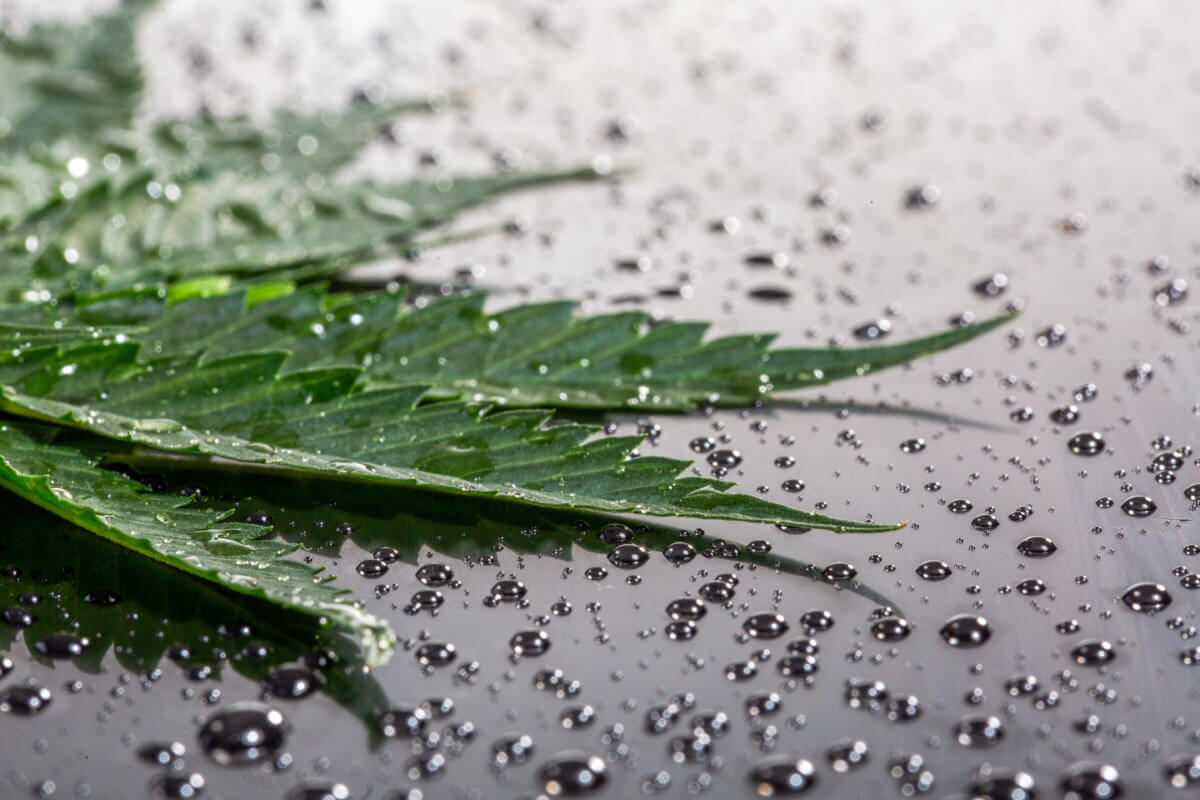
by Ashlyn East and Angel Fernandez, MyFloraDNA
Unfortunately, there are a variety of insects with the potential to damage the majority of your cannabis plants. Before we can fight back, we must be able to identify each symptom an insect may leave behind. Symptoms often vary amongst individual pests allowing us to identify them and treat the plant accordingly. This blog serves to highlight some of the biggest threats to cannabis gardens, including the following insects:
- Aphids
- Spider Mites
- Fungus Gnats
- Thrips
An aphid is a soft-bodied insect with a piercing-sucking mouthpart, allowing it to access a plant’s vascular system and steal its nutrients. They are visible to the naked eye but come in various colors, sometimes blending into the plant and making them hard to spot.
So, how can we know if aphids are present in our cannabis plants? According to Ryan Douglas, author of “Playing Plant Detective: How to Identify Insect “Fingerprints,” these insects often leave behind a smokey mold or “sooty mold,” consisting of a black or brown fungal disease. Aphids are mainly attracted to the protein within the sap of the plants, so the rest of the sugars in the sap pass through their body and are left behind on the leaves. This forgotten waste is known as honeydew and does not stay forgotten for long as ants are highly attracted to it. With this in mind, some other signs to be aware of are the collection of ants and left-over honeydew.
For preventative and exterminate measures, regularly check your plant for symptoms of the pest, remove and spray off as many bugs as possible, and also consider insecticide soaps and sprays that will not harm your plants.
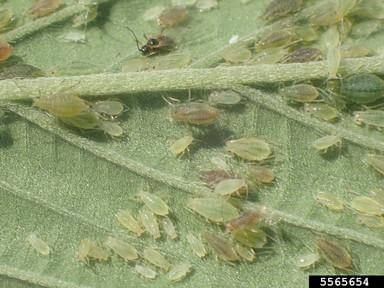
Figure 1. Aphids in different phases of life
Spider Mites
Spider mites are smaller than aphids but still visible to the naked eye. They are often dark red, orange, or brown. Spider mites also have tiny piercing mouths that allow them to feed on nutrients obtained from the plant leaves.
It can be hard to spot their presence in the early stages, as they tend to remain under the plant leaves until their population expands. Once the populace has reached a larger capacity, spider webbing will be present along the top of the plant canopy. In addition, the mites will often leave behind little white specks on the top of the leaf. The idea is to spot the mites before webbing occurs; this can be done by frequently and thoroughly examining your plants.
Early detection of spider mites is vital for exterminating and preventing their growth. According to Nebula Haze, author of “Cannabis Pests, Bugs, & Viruses,” these mites quickly reproduce and gain immunity to extermination methods. Therefore, it is important to use multiple forms of extermination consistently to prevent their return.
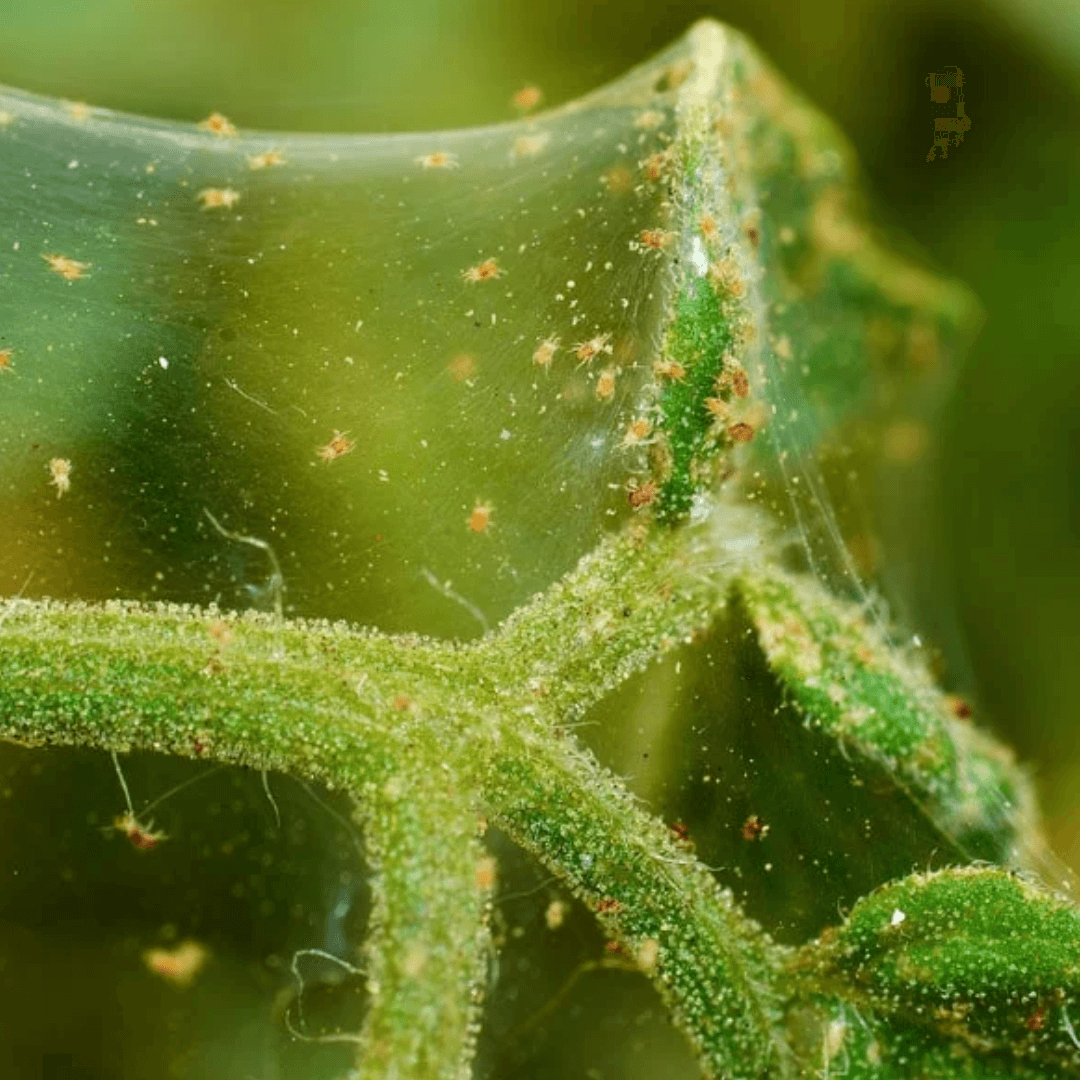
Figure 2. Spider mite webbing on a cannabis plant
Fungus Gnats
Unlike aphids and spider mites, fungus gnats primarily feed on plant roots. These gnats look like tiny black flies and can have quite harmful effects on plants. Not only are the flies feeding on the roots, but the larvae destroy root hairs and young roots of the cannabis plants (Haze, 2022).
Fungus gnats are not as easy to trace because their usual resting spot on the plant allows them to blend in with the dark soil and surface area. A more visible clue of “fungus gnats is the presence of their feces on the leaves, nursery pots, and grow benches” (Douglas, 2022). If there happens to be any flying bugs around the plant, that could also be a prominent symptom.
Ensuring prevention and extermination are possible from a variety of practices. Be sure not to over-water the plants, as gnats a more attracted to overly damp areas. It may also be helpful to hang sticky cards near your plants and, once again, utilize insecticide sprays when necessary.
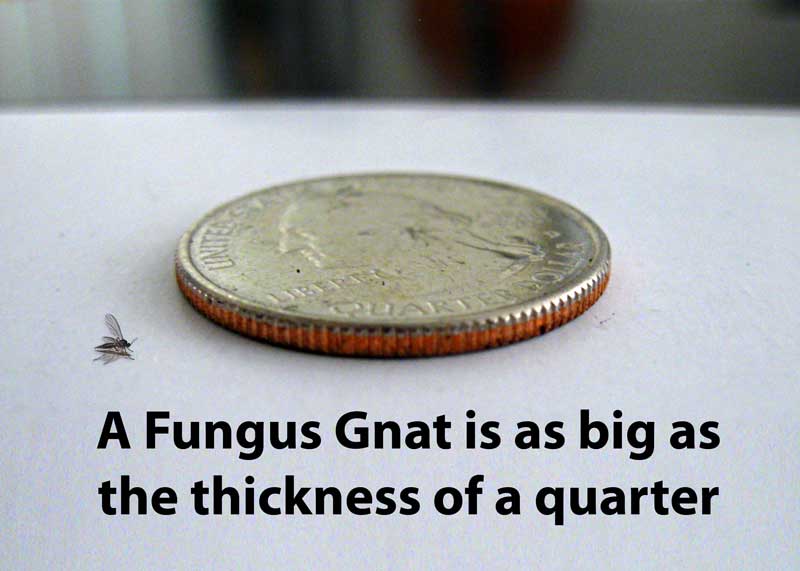
Figure 3. Fungus gnat, in comparison to a quarter
Thrips
A thrip is yet another insect that raises a threat to the healthy growth of cannabis plants. “Adult thrips are small, fast-moving insects, while young thrips look like tiny unmoving pale worms on the leaves” (Haze, 2022). Depending on their stage of life, they could look a variety of ways. They often blend into the plant because of their color and will jump around if they feel threatened. These variables cause their extermination to be quite tricky.
Thrips have small, piercing mouths like spider mites and aphids, but the leaves often look more scraped than pierced (Douglas, 2022). Douglas gives a great suggestion to test a plant for thrips. If you hold a white piece of paper under the suspected leaf and tap on the leaf, you will be able to see the thrips fall on the paper. As adults, they will typically appear as orange, brown, or yellow.
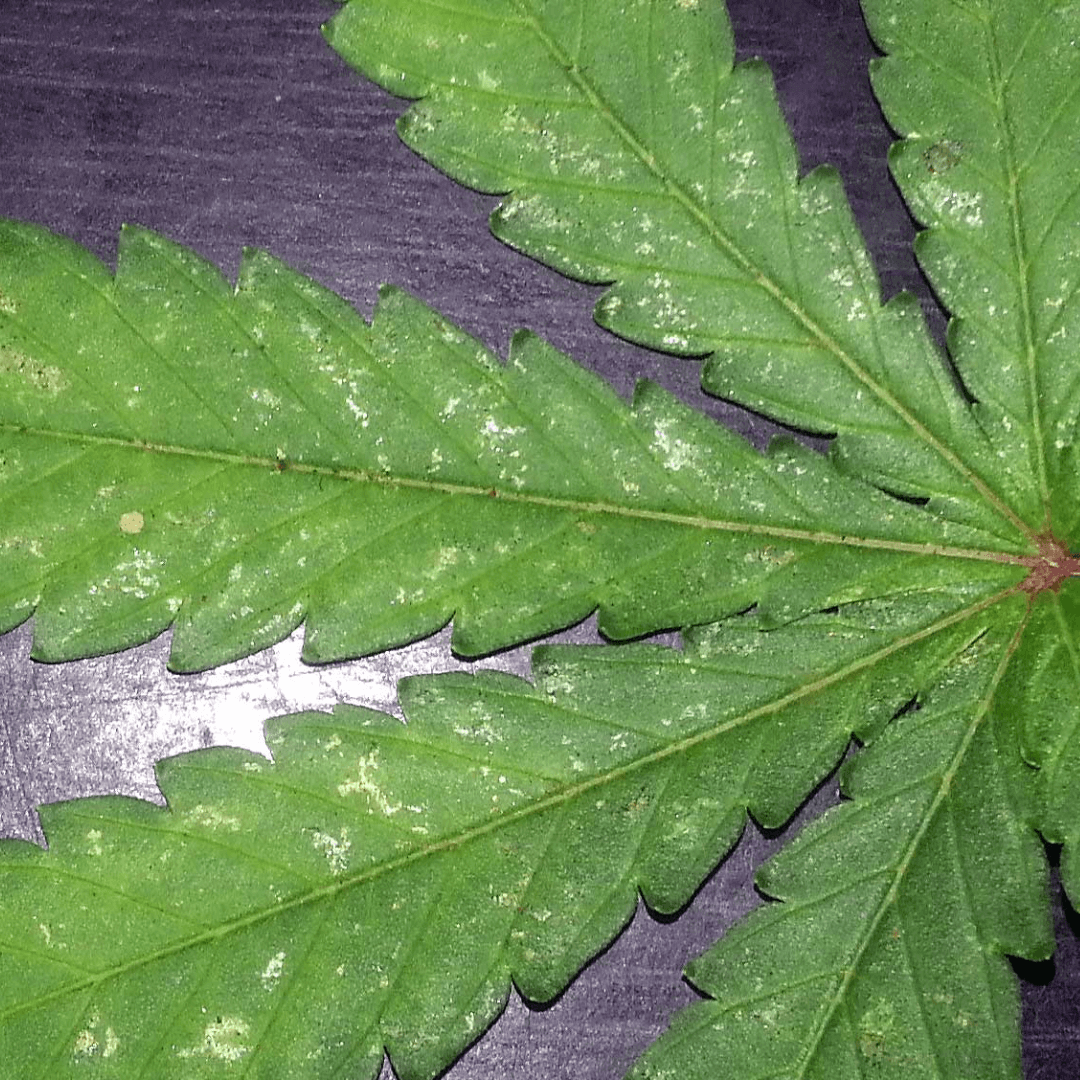
Figure 4. Thrip-damaged leaf
Examining your cannabis plants regularly makes the prevention or early diagnosis of pests a manageable task. As you examine your plants, keep in mind the range of symptoms that stem from various insects. In the end, if you happen to come across any harmful pests, be diligent in your extermination methods and find the necessary method according to the pest you discover.
References
- Haze, N. (2022, August 7). Complete pest guide – cannabis pests, bugs & viruses. Grow Weed Easy. Retrieved October 19, 2022, from https://www.growweedeasy.com/bugs-pests-symptoms-marijuana-grow
- Figure 1: https://content.ces.ncsu.edu/cannabis-aphid-in-industrial-h
Photographer: Whitney Cranshaw, Colorado State University, Bugwood.org
About MyFloraDNA: We are a genomic laboratory based in Woodland California, delivering modern genomics for the Cannabis Industry.
Our services include Trait detection (cannabinoid profile and sex/gender ID), Pathogen Detection, and Genetic Validation Services. We offer breakthrough solutions using the inner power of your plants.
Authors: Ashlyn East and Angel Fernandez
Angel Fernandez, CEO & Co-Founder at MyFloraDNA. “It is time to fill in the gap between DNA Sciences and Agriculture. MyFloraDNA is willing to show the huge opportunities that exist for modern genetics in agriculture. Now, it is time for another agricultural revolution”
Editor: Maria Zuccarelli
Member Blog: How to Prevent Pathogen Infections in Cannabis Gardens
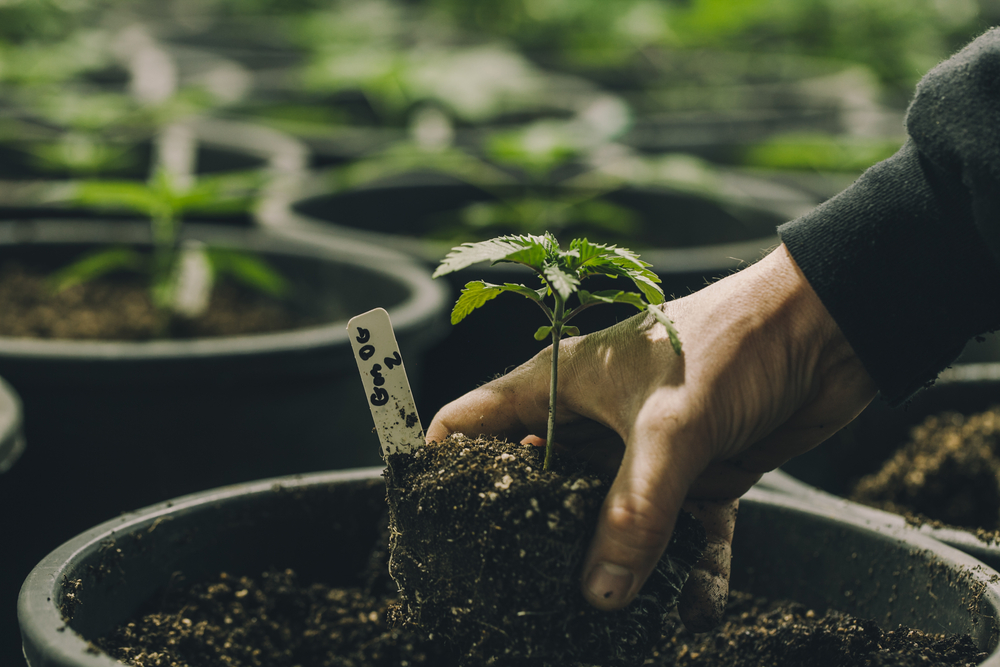
by María Zuccarelli, MyFloraDNA
One pathogen can spread through a garden and ruin everything that was going well.
A pathogen is “an organism causing the disease to its host, with the severity of the disease symptoms referred to as virulence.” (NCBI) There are different kinds of pathogens. These are the main three infecting cannabis crops:
- Viruses (ex. Cannabis Cryptic Virus)
- Viroids (ex. Hop Latent Viroid)
- Fungus (ex. Botrytis)
Well, here are five recommendations approved by Dr. Angel Fernandez – Ph.D. in plant science with a complete background in cannabis genetics and genomics, CEO and Co-Founder of MyFloraDNA – The following recommendations will impede the spread of a pathogen in your cannabis garden so the next time you’re prepared for a worst-case scenario.
1. The first step: remove.
If a plant’s result comes out positive, it must be removed from the field or greenhouse as soon as possible, without exposing it directly to other plants.
2. Destroy.
Ironically, the best solution to avoid the destruction of your garden is to dispose of infected plants. If the infection is in a mother plant, remember to remove its clones from your growing facility and test them as fast as possible with your trusted genomic laboratory.
3. Don’t deny it, take action and prevent the spread.
If one plant is positive, assume the viroid is present in your field and extreme your prevention strategies.
- Sterilize all tools used
- Control your personnel and visitors
- Do not jump from one plant to another without sterilizing your equipment
4. Don’t look away and take responsibility for your problem. Test regularly.
It doesn’t matter if other plants don’t return positives. Some pathogens remain dormant for weeks (like Botrytis or “bud rot”). Stay alert and test regularly.
5. Keep an eye on pests, they are pathogens’ best friends.
Control pests. One of the causes of quick pathogen propagation in Cannabis fields is pest infections, like Whiteflies.
How do you know if a plant is infected?
It might sound obvious, but pay attention to the symptoms. Anyways, the most effective way is by requesting RNA testing from your trusted genomic laboratory.
RNA testing for pathogen detection is the easiest way to detect infected plants. The results are obtained through the qPCR method, determining whether your samples are positive or negative for the pathogen you wish to detect.
The top 7 cannabis pathogens are:
Commonly known as Dudding Disease. HLV is a single-stranded, circular infectious RNA viroid (it is not a virus).
Symptoms during vegetative stage: stunted growth, outward growth, abnormal branching, small leaves, overlapping blades, brittle stems, chlorosis on the leaves (yellow leaves),
Symptoms during flowering stage: trichome reduction, dull smell, no terpenes or reduction of terpenes, reduction of cannabinoid production, smaller buds.
This RNA virus can infect plants.
Symptoms: yellowing leaves showing necrosis, chlorotic leaves, lower yield, and leaf thickness.
Beet curly top virus (BCTV) is a plant virus-containing single-stranded DNA.
Symptoms: Leaf curling, yellowing of leaves with purple veins, death of young seedlings, bud deformation, reduced bud quality, and yield.
Cannabis Cryptic Virus (CCV) is a double-stranded RNA virus that is known to infect plants without causing obvious symptoms.
Symptoms: Rolling and/or yellow leaves, smaller buds, fewer trichomes, cannabinoids, and terpenes.
The main problem with this virus is that once plants are infected, there is no cure for mosaic viruses. For this reason, PREVENTION is KEY!
Symptoms: Severe stunting of plants, yellow mosaic or calico patterns occur on the foliage, and plants grow slowly and generally produce poor yields.
This mold is one of the most damaging fungi that can kill cannabis plants within a week. It can remain dormant for long periods of time before damaging your plant.
Symptoms: Brown, water-soaked spots on buds, chlorotic areas on stems, gray-brown mass of spores on buds, interveinal yellowing leaves showing necrosis, and smaller buds.
Fusarium is a devastating fungus pretty frequent on cannabis crops.
Symptoms: wilts and bud, crown, and root rots, chlorotic leaves, stunted growth, plant death.
I am glad you kept reading until here and hope this guide helps you to keep growing healthy and safe cannabis plants!
Also, here are some interesting topics you may like when you click on them before you close this tab:
 About MyFloraDNA: We are a genomic laboratory based in Woodland California, delivering modern genomics for the Cannabis Industry. \
About MyFloraDNA: We are a genomic laboratory based in Woodland California, delivering modern genomics for the Cannabis Industry. \
Our services include Trait detection (cannabinoid profile and sex/gender ID), Pathogen Detection, and Genetic Validation Services. We offer breakthrough solutions using the inner power of your plants.
Author: María Zuccarelli – Marketing Manager at MyFloraDNA.
Marketing expert, with a portfolio of innovative and successful projects around the world. Native leader, resolutive and efficient. She brings creativity and proactivity to MyFloraDNA’s Marketing Department.
Editor: Felipe Cisternas
Member Blog: Top 6 Pathogens Seen in Cannabis Plants

By Angel Fernandez and Felipe Cisternas, MyFloraDNA
Pathogens cause diseases when looking for a host body to infect. They come in diverse forms: bacteria, fungi, worms, viruses, and also prions. Pathogens are one of the significant threats to cannabis fields. These silent visitors may cause your plants to produce fewer trichomes, small buds, or even death.
Identifying each pathogen will help to understand how each of them propagates, its symptoms, and its consequences. In this blog, you’ll find everything you need to know about:
- Hop Latent Viroid
- Botrytis (gray mold)
- Cannabis Cryptic Virus
- Lettuce Chlorosis Virus
- Alfalfa Mosaic Virus
- Beet Curly Top Virus
Hop Latent Viroid
Hop Latent Viroid (HLV) is a single-stranded infectious RNA that interferes with cannabis plant growth. Once the Hop Latent Viroid has infected the plant, the obvious sign of infection is dudding, which is when the plant grows smaller, shorter leaves in the process. HLV can also cause other symptoms, such as yellowing, and necrotic and malformed leaves.
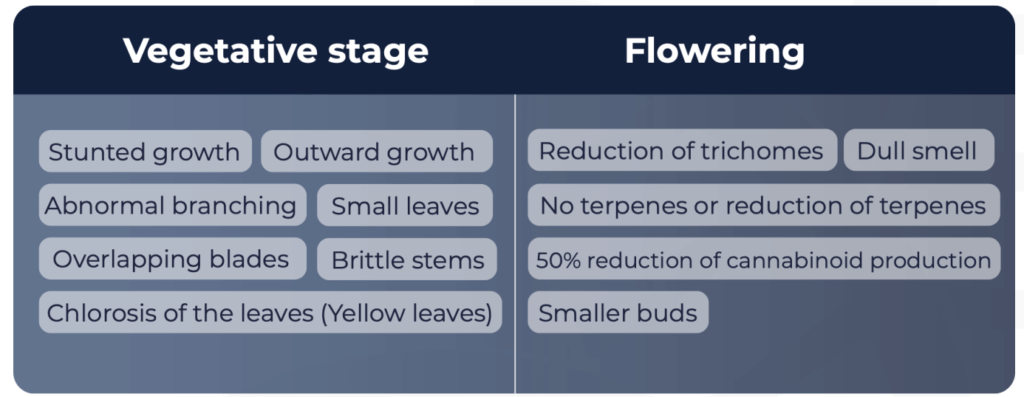
These plants will have fewer traces of trichomes in their structure. Detecting HLV on time is crucial to avoid an existential threat to the entire garden.
Botrytis Cinerea
Botrytis Cinerea, or bud rot, is a fungus that damages the tender parts of plants in areas of high humidity. This necrotrophic fungus will invade damaged tissue. The symptoms include smaller buds, the development of gray mass spores, and brown, water-soaked spots found on leaves. A major consequence of this fungus is that it can kill cannabis plants within a week.
Lettuce Chlorosis Virus
Much like Botrytis Cinerea, Lettuce Chlorosis Virus can potentially destroy an entire garden. Likewise, Lettuce Chlorosis Virus occurs in lettuce grown in southern California. The plants change into a frail yellow color. They will become very brittle and stunted. One way to prevent the virus from spreading is to take a sample of tissue from a cannabis plant and perform qPCR tests to make sure the plant is virus free.
Cannabis Cryptic Virus
Cannabis Cryptic Virus is a double-stranded RNA virus causing subtle symptoms to plants. Some of these symptoms include smaller flower quality and stunted growth. Thus, this virus can affect plants by producing fewer terpenes, cannabinoids, and trichomes, which are three essential components that serve different purposes for cannabis plants.
Alfalfa Mosaic Virus
Another pathogen is Alfalfa Mosaic Virus, the virus starts by killing cells within a plant and this can be a potential problem for groups of plants. Aphids, small insects, will begin to infect one plant after another as they move and transmit the virus instantly. Seed transmission is also a possibility. There’s no known cure so it is best to care for plants to avoid infection from this type of virus. The symptoms are the same as many of the previous viruses and diseases; stunted growth, slower yield, and calico or yellow color is typically seen on leaves. The good thing is that this can be detected on time by performing serological tests, or antigen and antibody tests to help prove immune status.
Beet Curly Top Virus
Lastly, Beet Curly Top Virus is a dangerous plant virus containing a single-stranded DNA that can affect all kinds of plants, especially cannabis plants, giving them a serious infection. Symptoms include showing a yellow color with purple veins, leaves beginning to curl, seedlings dying out, and deformation beginning at the buds. Since this virus contains a protein carrying a unique code that allows for host cell replication if the virus is not detected on time the cannabis plants will die.
Recognizing the danger these pathogens pose to cannabis plants, and acknowledging their potential to prevent cultivation is very important for growth and success.
If you would like to know more about cannabis pathogens and how to prevent infections in your garden, download our free guides about How to treat Infected Material and The Ultimate Hop Latent Viroid Guide.
Keep growing safe and healthy cannabis!
 Author: Angel Fernandez, CEO & Co-Founder at MyFloraDNA. “It is time to fill in the gap between DNA Sciences and Agriculture. MyFloraDNA is willing to show the huge opportunities that exist for modern genetics in agriculture. Now, it is time for another agricultural revolution”
Author: Angel Fernandez, CEO & Co-Founder at MyFloraDNA. “It is time to fill in the gap between DNA Sciences and Agriculture. MyFloraDNA is willing to show the huge opportunities that exist for modern genetics in agriculture. Now, it is time for another agricultural revolution”
Co-author: Felipe Cisternas, Intern at MyFloraDNA
Editor: Ashlyn East, Intern at MyFloraDNA
About MyFloraDNA: We are a genomic laboratory based in Woodland California, delivering modern genomics for the cannabis industry. MyFloraDNA provides data-driven decisions to help breeders increase their plant yields.
Our services include Trait detection (cannabinoid profile and sex/gender ID), Pathogen Detection, and Genetic Validation Services. We offer breakthrough solutions using the inner power of your plants.
Who asks if you think you have an infection in your garden?
We highly recommend you consult with DNA Laboratories. They will guide you through the process, test your plants, and let you know if they are infected with HLV or not.
Member Blog: Genetics Validation – Certified Growers and Cultivar Identification

by María Zuccarelli and María Belén de Catarina, MyFloraDNA

It’s pretty easy to differentiate humans from one another, except for twins, that’s a more tricky situation.
With plants, it is not that easy. It takes time and a lot of expertise to differentiate each species. Imagine the difficulty to distinguish with 100% precision one cultivar from another within the same species!
Cannabis breeders, nurseries, and growers face this challenge from the beginning of their journey, cultivating and developing new cultivars.
It’s a fact that nowadays people do not know exactly which cultivar (miss-called strain) is growing, much less what they are actually consuming.
You can find out which cultivar you are growing by determining physical attributes such as smell, color, leaf shape, etc.
“Online databases such as Leafly (2018) and Wikileaf (2018), for example, provide consumers with information about strains but lack scientific merit for the cannabis industry to regulate the consistency of strains.” affirms Schwabe and McGlaughlin (2019).
Over time, cannabis growers and geneticists realized the importance of finding an efficient way to determine the genotype of a plant accurately.
Other industries use DNA Fingerprinting to differentiate cultivars and effectively categorize and relate them. They’ve realized that this solution works identically to physical fingerprints, so it can be used to identify cultivars or genes among generations.
But, how can we use genomic images for the cannabis business?
- Identification of cannabis cultivars using their unique genetic profile
- Identification of plant species, varieties, clones, individuals, and even plant products
- Guarantee genetic quality and ownership
- Authenticate the nature and origin of the plant
- Validate the genetic inventory and stockage
- Register and protect new cannabis cultivars
- Construction of evolutionary and phylogenetic trees
The main goal of this application is to protect the breeders and provide recognition to the creators of the new plant cultivars. Also, this analysis can lead to conscious consumption in this industry and highlight the positive effects that cannabis can have on society.
“Currently, the Cannabis industry has no way to verify strains. Consequently, suppliers are unable to provide confirmation of strains, and consumers have to trust the printed name on a label matches the product inside the package,” says Schwabe and McGlaughlin (2019).
It is important to move towards responsible cannabis production, where growers and consumers know what effect our products will cause. Recognizing precisely what cultivar growers and nurseries are growing and selling is our responsibility.
For this, the DNA fingerprint is a very useful tool. It allows the cannabis industry to build a responsible and conscious production system. Let’s Imagine the power to know in advance which cultivars have to cross to obtain a new one that enhances/improves the final effects and experiences patients and recreational users will have. This is possible if we effectively characterize, define, and categorize each cultivar.
Dr. Angel Fernandez, a plant scientist from UC Berkeley and Co-Founder of MyFloraDNA, discovered and patented a process based on DNA fingerprinting that enables him to build a genetic image representing a cannabis cultivar’s simplified genome. He calls it “Molecular ID.” Every single cultivar already has its own genomic and unique logo inside them, this solution enables us to see it.
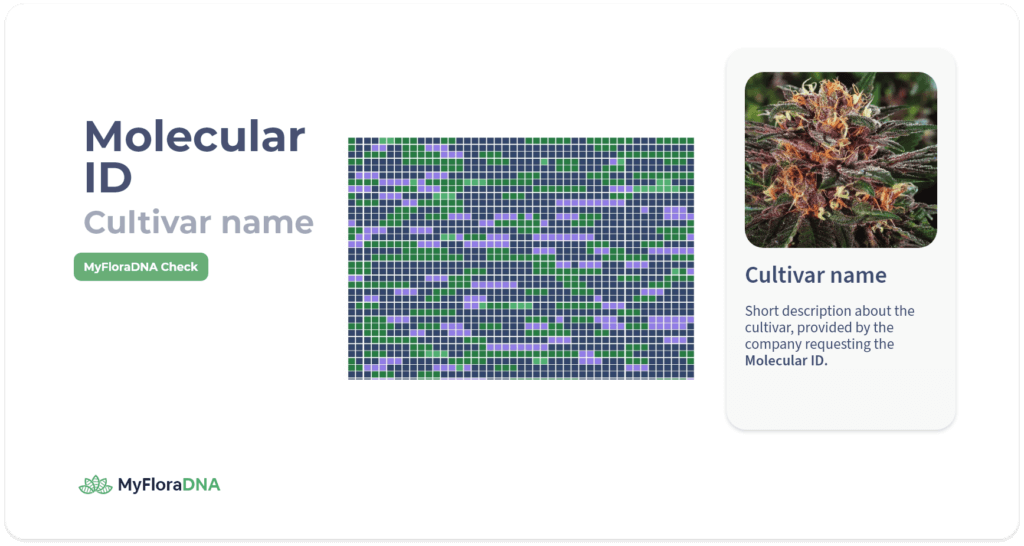
In the image, each square represents a molecular DNA marker and the whole combination of squares are unique to every cultivar. Two different cultivars with the same Molecular ID do not exist, that’s what makes it interesting.
Angel discovered that this particular code could be used in more than one way, bringing the cannabis industry new ideas and solutions. It is a universal code that serves to compare and differentiate cannabis cultivars.
Using the Molecular ID, breeders will be able to capture their plants’ genomic logo, using it as a reference, ID, or even a comparison method. The most important thing about this new technique is that everybody will be able to use it as a standardized genomic procedure for their genetics.
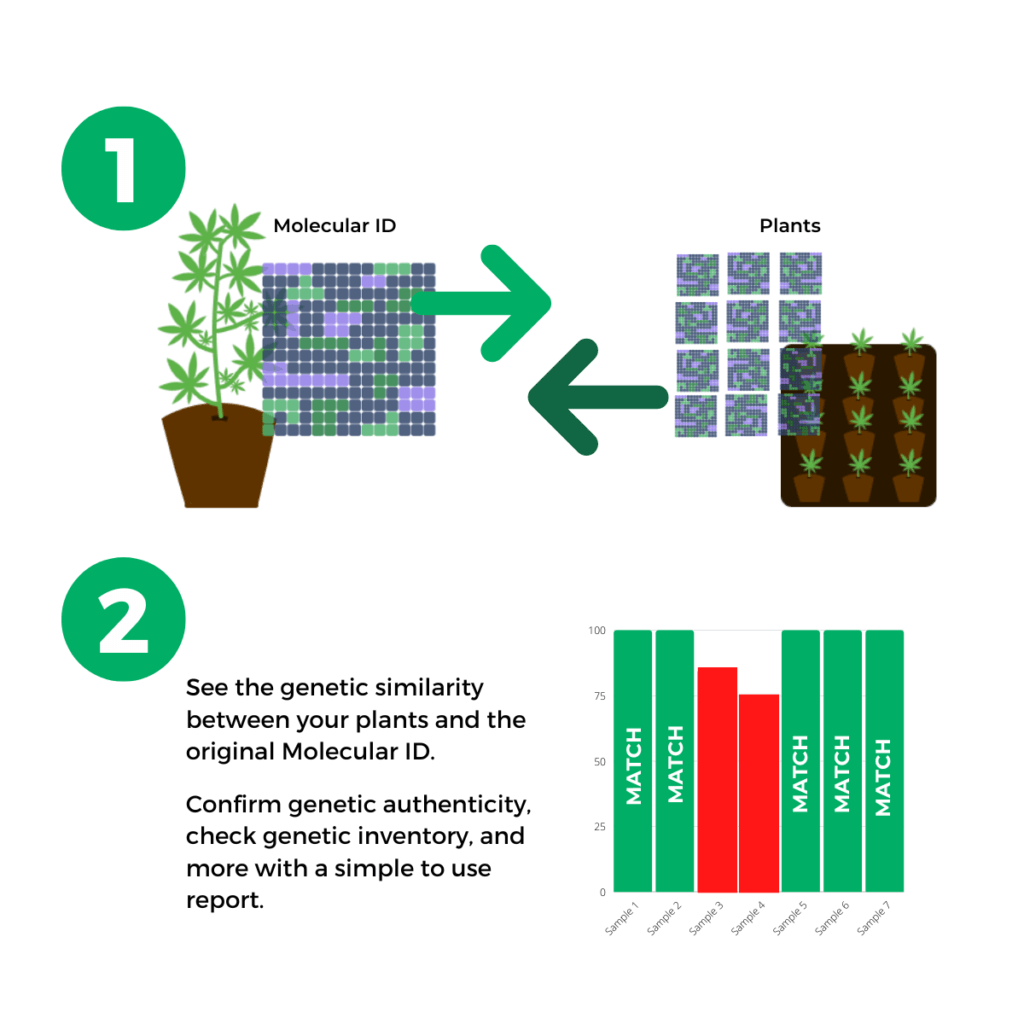
Example about one application of Molecular ID
Like everything in the cannabis industry, nothing is possible without the collaboration of all different players. Let’s continue building a conscious and more efficient and sustainable industry.
If you’re curious and would like to know more about this new solution, download our free ebook to read more about how to use genomic information to take your cannabis business to the next level by clicking here.
What do you think about this new genomic solution? Is it going to be even more confusing or helpful?
We’re delighted to read your opinions
 About MyFloraDNA: We are a genomic laboratory based in Woodland California, delivering modern genomics for the Cannabis Industry. \
About MyFloraDNA: We are a genomic laboratory based in Woodland California, delivering modern genomics for the Cannabis Industry. \
Our services include Trait detection (cannabinoid profile and sex/gender ID), Pathogen Detection, and Genetic Validation Services. We offer breakthrough solutions using the inner power of your plants.
Author: María Zuccarelli – Marketing Manager at MyFloraDNA.
Marketing expert, with a portfolio of innovative and successful projects around the world. Native leader, resolutive and efficient. She brings creativity and proactivity to MyFloraDNA’s Marketing Department.
Co-author: María Belén de Catarina
Editor: Ashlyn East and Juana Daroda
Member Blog: What Growers Should Know About Hop Latent Viroid
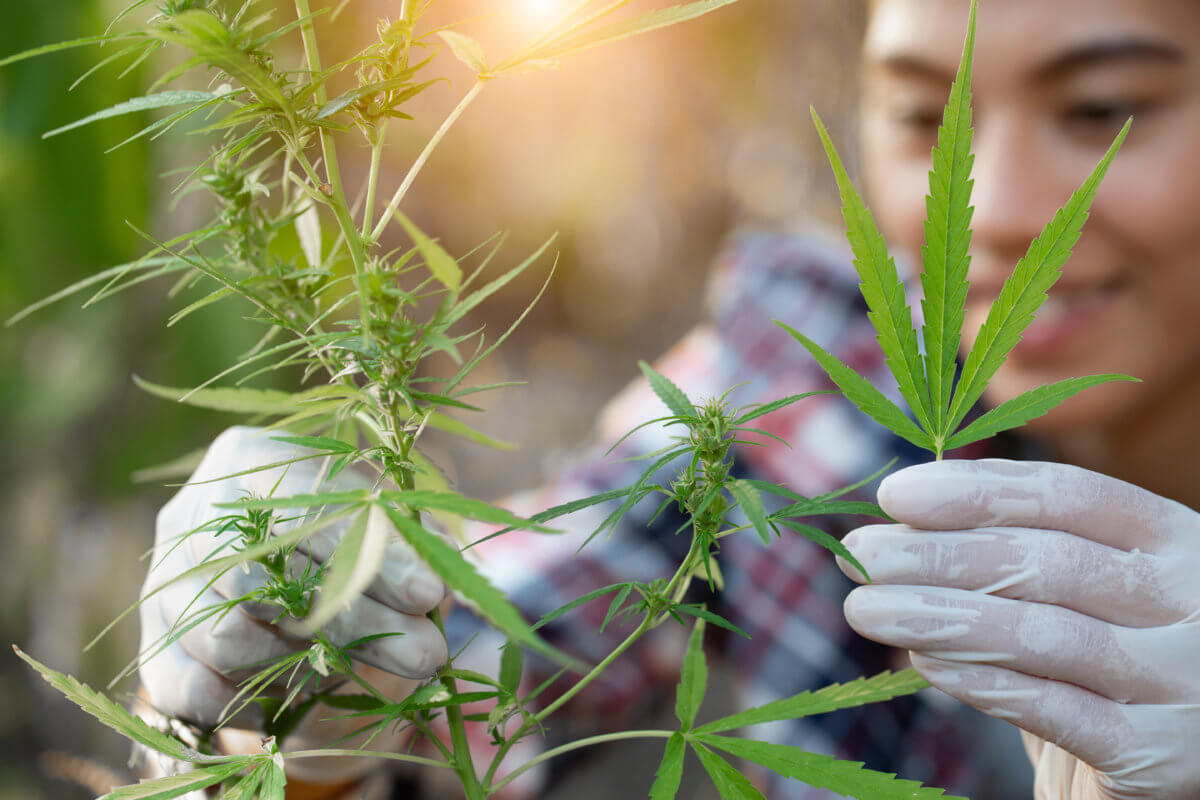
by Angel Fernandez, María Zuccarelli, and María de Catarina, MyFloraDNA
For many years, growers and breeders have speculated why “dud plants” are seen across different cannabis crops.
It is a fact that cannabis has faced many viral infections. Due to viruses and viroids, some varieties mutated into genetic changes over time, altering the evolution of the plant.
But… how can we detect Hop Latent Viroid (HLV)?
Hop Latent Viroid (commonly known as Dudding Disease) is a single-stranded, circular infectious RNA. It is not a virus. Let us explain the difference:
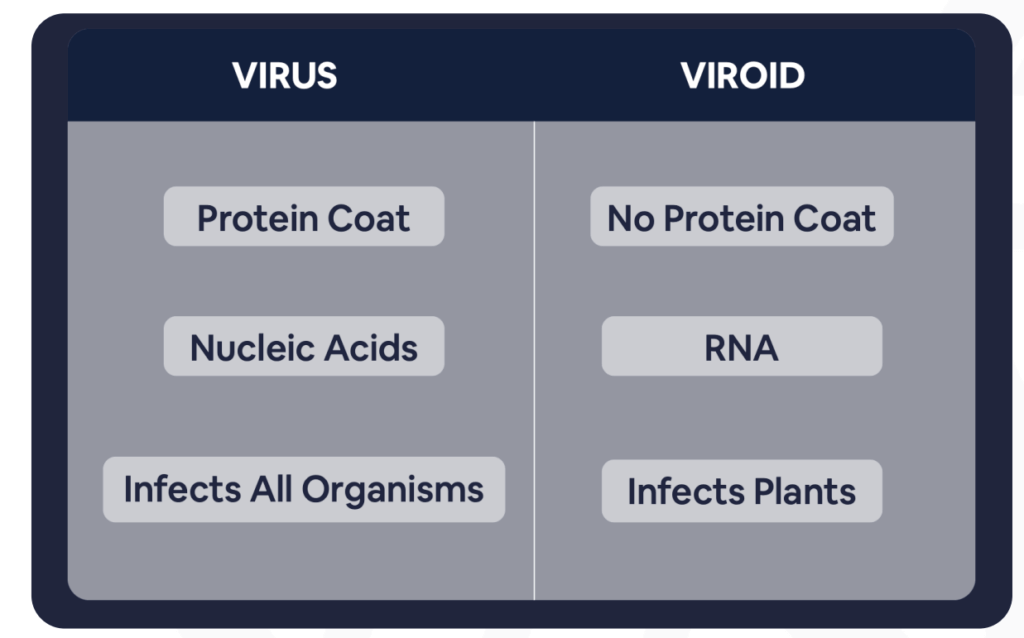
Viroids only replicate in plants. Also, viruses are more complex than viroids. Viroids are compounded by only RNA, while viruses are composed of a protein capsule enveloping their genetic material.
Viruses infect new hosts only once they enter a host and replicate on it. Viroids are transmitted through direct contact of a healthy plant with an infected one. Also, can be transmitted by contaminated tools and instruments (gloves, scissors, tweezers, even human hands).
Talking about HLV, we must remember that this viroid is latent, so there are many asymptomatic transmissions. It can spread without symptoms, and you will only realize it when it is too late.
HLV Symptoms:
HLV is a silent viroid, meaning that this viroid may or may not show early visual clues from its presence. Some physical symptoms in cannabis plants are:
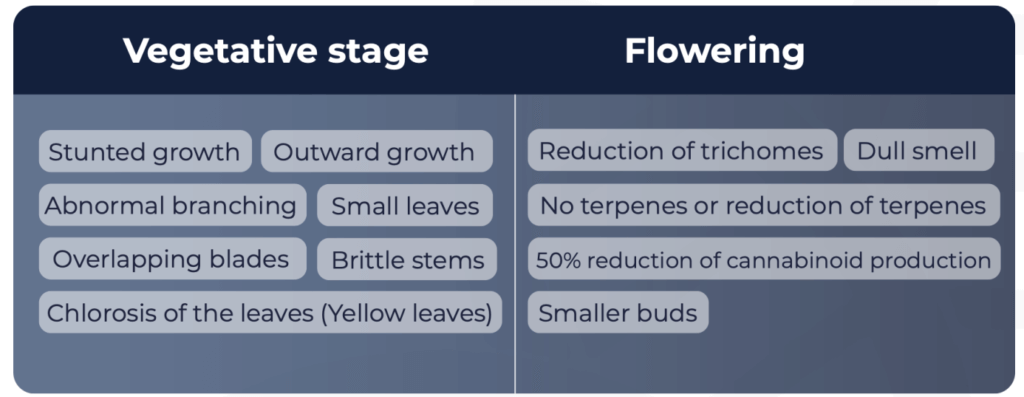
What about transmission?
This issue is important, so please take note. If you have any doubts about an infection of Hop Latent Viroid in your garden, TREAT EVERYTHING AS IF IT IS INFECTED. Download here our guide on how to treat infected material.
HLV and other viroids in your garden or greenhouse can spread quickly from infected to healthy plants. The main transmission causes are:
- Infected equipment: sterilize the equipment before working on new plants to reduce the possibility of contamination.
- Clones: before cutting, we recommend doing a complete pathogen test, to avoid infected clones.
- Seeds: this is currently under research, but HLV has an 8% chance of being present in the seeds of an infected mother plant.
- Human touch: cultivation managers and staff have to sterilize their hands and gloves before jumping from one plant to another. A simple touch is enough to transmit HLV.
- Bugs and pests: bugs and pests are always present, and their bites may transmit HLV, spreading the pathogen through your entire garden in a blink of an eye.
How can you prevent HLV?
Here are some essential tips:
- Keep your equipment clean. You can read more about how to sterilize your tools on our Instagram profile.
- Make sure you have pests under control
- Tissue culture: HLV can travel through the plant’s vascular system and may be left behind in older tissues as plants develop. It can outgrow the problem by producing clones from the infected plant. The more cuttings a grower roots, the higher the chances of selecting a clean one.
- Pay special attention when visits come by: HLV may come in a visitor’s hand, glove, or even shoes!
- When a plant or leaf enters, please do not accept it unless it has a negative DNA HLV test. It is the only way you can be sure it is not a threat to your garden.
 Who asks if you think HLV may be in your garden?
Who asks if you think HLV may be in your garden?
Thank you for reading! We hope you find this information useful. In case of any doubts, do not hesitate to ask us regarding any related topic and download our Complete HLV Guide here. We highly recommend you consult with DNA Laboratory. They will guide you through the process, test your plants, and let you know if they are infected with HLV or not.
Angel Fernandez, CEO & Co-Founder at MyFloraDNA. “It is time to fill in the gap between DNA Sciences and Agriculture. MyFloraDNA is willing to show the huge opportunities that exist for modern genetics in agriculture. Now, it is time for another agricultural revolution”
Co-author: María Zuccarelli, CMO at MyFloraDNA.
Editor: María de Catarina, PR Intern at MyFloraDNA.
About MyFloraDNA: We are a genomic laboratory based in Woodland California, delivering modern genomics for the Cannabis Industry.
Our services include Trait detection (cannabinoid profile and sex/gender ID), Pathogen Detection, and Genetic Validation Services. We offer breakthrough solutions using the inner power of your plants.

 About MyFloraDNA: We are a genomic laboratory based in Woodland California, delivering modern genomics for the Cannabis Industry. \
About MyFloraDNA: We are a genomic laboratory based in Woodland California, delivering modern genomics for the Cannabis Industry. \







 About
About 
 Author:
Author: 





 Who asks if you think HLV may be in your garden?
Who asks if you think HLV may be in your garden?